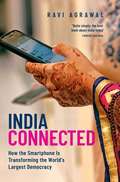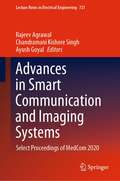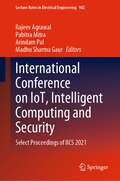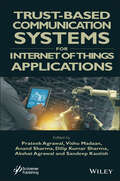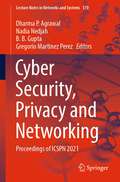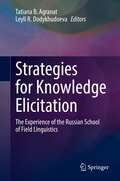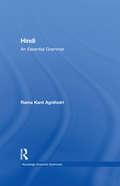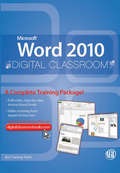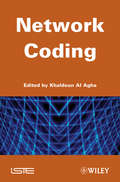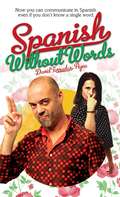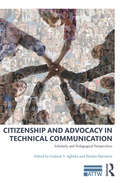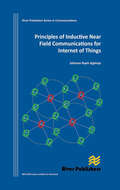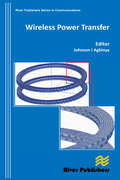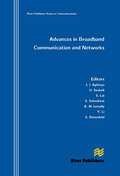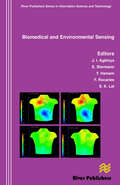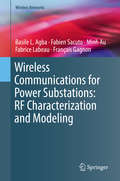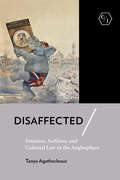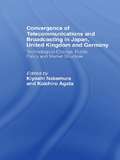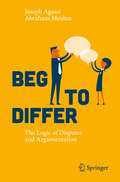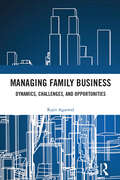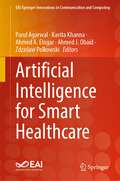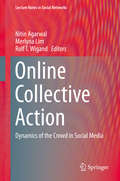- Table View
- List View
India Connected: How the Smartphone is Transforming the World's Largest Democracy
by Ravi AgrawalIndia is connecting at a dizzying pace. In 2000, roughly 20 million Indians had access to the internet. In 2017, 465 million were online, with three new people logging on for the first time every second. By 2020, the country's online community is projected to exceed 700 million; more than a billion Indians are expected to be online by 2025. While users in Western countries progressed steadily over the years from dial-up connections on PCs, to broadband access, wireless, and now 4G data on phones, in India most have leapfrogged straight into the digital world with smartphones and affordable data plans. What effect is all this having on the ancient and traditionally rural culture dominated by family and local customs? Ravi Agrawal's book explores that very question, seeking out the nexuses of change and those swept up in them. Smartphones now influence arranged marriages, create an extension of one's social identity that moves beyond caste, bring within reach educational opportunities undreamed of a generation ago, bridge linguistic gaps, provide outlets and opportunities for start-ups, and are helping to move the entire Indian economy from cash- to credit-based. The effects are everywhere, and they are transformative. While they offer immediate access to so much for so many, smartphones are creating no Utopia in a culture still struggling with poverty, illiteracy, corruption, gender inequality, and income disparity. Internet access has provided greater opportunities to women and altered how India's outcasts interact with the world; it has also made pornography readily available and provided an echo chamber for rumor and prejudice. Under a government determined to control content, it has created tensions. And in a climate of hypernationalism, it has fomented violence and even terrorism. The influence of smartphones on the world's largest democracy is pervasive and irreversible, disruptive and creative, unsettling and compelling. Agrawal's fascinating book gives us the people and places reflecting what the internet hath wrought. India Connected reveals both its staggering dimensions and implications, illuminating how it is affecting the progress of progress itself.
Advances in Smart Communication and Imaging Systems: Select Proceedings of MedCom 2020 (Lecture Notes in Electrical Engineering #721)
by Rajeev Agrawal Chandramani Kishore Singh Ayush GoyalThis book presents select and peer-reviewed proceedings of the International Conference on Smart Communication and Imaging Systems (MedCom 2020). The contents explore the recent technological advances in the field of next generation communication systems and latest techniques for image processing, analysis and their related applications. The topics include design and development of smart, secure and reliable future communication networks; satellite, radar and microwave techniques for intelligent communication. The book also covers methods and applications of GIS and remote sensing; medical image analysis and its applications in smart health. This book can be useful for students, researchers and professionals working in the field of communication systems and image processing.
International Conference on IoT, Intelligent Computing and Security: Select Proceedings of IICS 2021 (Lecture Notes in Electrical Engineering #982)
by Rajeev Agrawal Pabitra Mitra Arindam Pal Madhu Sharma GaurThis book comprises select peer-reviewed papers from the International Conference on IoT, Intelligent Computing and Security, IICS 2021. The contents focus on the latest research in artificial intelligence, IoT, intelligent computing, and leading technological convergence security challenges. The book also discusses AI-driven automation of highly connected smart devices across the globe presenting the fast technological shift with the futuristic scenario, bursting perspective of IoT, computational intelligence, and security concerns. This book supports the transfer of vital knowledge to the next generation of researchers, students, and practitioners in academia and industry.
Trust-Based Communication Systems for Internet of Things Applications
by Prateek Agrawal Vishu Madaan Anand Sharma Dilip Sharma Akshat Agarwal Sandeep KautishTRUST-BASED COMMUNICATION SYSTEMS FOR INTERNET OF THINGS APPLICATIONS Highlighting the challenges and difficulties in implementing trust-based communication systems for Internet of Things (IoT) services and applications, this innovative new volume is a critical reference source for academics, professionals, engineers, technology designers, analysts, and students. The primary objective of this edited book is to deliver technologies to improve trust and eliminate malicious actors in participatory exchanges throughout communication using Internet of Things (IOT) devices such that these methods should not only be able to identify bad actors but also to improve communication and trust in the environment without violating object privacy. Whether as a reference for the engineer or scientist or a textbook for the student, this is a must-have for any library.
Cyber Security, Privacy and Networking: Proceedings of ICSPN 2021 (Lecture Notes in Networks and Systems #370)
by Dharma P. Agrawal Nadia Nedjah B. B. Gupta Gregorio Martinez PerezThis book covers selected high-quality research papers presented in the International Conference on Cyber Security, Privacy and Networking (ICSPN 2021), organized during 17-19 September 2021 in India in Online mode. The objectives of ICSPN 2021 is to provide a premier international platform for deliberations on strategies, recent trends, innovative approaches, discussions and presentations on the most recent cyber security, privacy and networking challenges and developments from the perspective of providing security awareness and its best practices for the real world. Moreover, the motivation to organize this conference is to promote research by sharing innovative ideas among all levels of the scientific community, and to provide opportunities to develop creative solutions to various security, privacy and networking problems.
Strategies for Knowledge Elicitation: The Experience of the Russian School of Field Linguistics
by Tatiana B. Agranat Leyli R. DodykhudoevaThis volume provides an overview of experimental methods, approaches, and techniques used by field linguists of the Russian school, and highlights the fieldwork experience of Russian scholars working in regions with a range of languages that differ genetically, typologically, and in the degree of their preservation.The collection presents language and sociolinguistic data relating to fieldwork in diverse languages: Uralic, Altaic, Paleo-Siberian, Yeniseian, Indo-European Iranian, Vietic, Kra-Day, and Mayan languages, as well as pidgin.The authors highlight the fieldwork techniques they use, and the principles underlying them.The volume’s multidisciplinary approach covers linguistic, ethnolinguistic, sociolinguistic, educational, and ethnocultural issues. The authors explore problems associated with the study of minority languages and indicate diverse and creative techniques for data elicitation. Close collaboration with speakers lies at the core of their approach. The collection presents strategies for eliciting systems of knowledge from mother-tongue speakers, triggering linguistic self-awareness, and providing semantic and morphosyntactic context for their languages.This publication is intended for academics, and for specialists in the field of linguistics and minority and indigenous languages. It will also benefit students as a guide to field research, as well as language activists, interested in documenting and preserving their mother tongue.
Hindi: An Essential Grammar (Routledge Essential Grammars)
by Rama Kant AgnihotriThis text provides a reader-friendly guide to the structural patterns of modern standard Hindi. Ideal for both independent learners and classroom students alike, this book covers the essentials of Hindi grammar in readable, jargon-free sections. Key features include: sections on the speech sounds of Hindi detailed analysis of Hindi sentence structure full examples throughout.
Social Influences on Romantic Relationships
by Christopher R. AgnewHow do we choose a partner to initiate a relationship with, and what makes us stay in a given relationship over time? These questions are most often pursued by scholars with an emphasis on the internal thoughts, feelings, and motivations of individual decision-makers. Conversely, this volume highlights the importance of considering external influences on individual decision-making in close relationships. Featuring contributions from internationally renowned scholars, the volume is divided into two interrelated sections. The first section considers global and societal influences on romantic relationships and the second focuses on social network and communicative influences on romantic relationships. Taken together, this collection helps us to better understand how external factors influence the internal machinations of those involved in intimate relationships.
Microsoft Word 2010 Digital Classroom (Digital Classroom #93)
by AGI Training TeamThe perfect book-and-video training package for Word 2010! This Word 2010 book-and-video training package-from the same professional training experts who also create many training materials for Adobe Systems-is like having your own personal instructor guiding you through each lesson, but you work at your own pace! The full-color ebook includes 8 lessons that teach you the new features and quirks of Microsoft Word 2010. Each lesson includes step-by-step instructions and lesson files, and provides valuable video tutorials that complement what you're learning and clearly demonstrate how to do tasks. This jam-packed training package takes you well beyond the basics in a series of easy-to-absorb, five-minute lessons. Walks you through 8 lessons, each consisting of easy-to-follow, step-by-step instructions and lesson files in full color that make each task less intimidating Includes all the lesson files from the book and video tutorials that clearly show you how to do tasks and reinforces what you're learning in the book Covers exciting new Word 2010 features such as Office Web apps that can be accessed from anywhere and a streamlined new Ribbon Provides the perfect, one-stop, robust learning package-with book and supplementary video training Additional resources available on companion Web site: www.digitalclassroombooks.com Learn the ins-and-outs of Word 2010!
Network Coding
by Khaldoun Al AghaNetwork coding, a relatively new area of research, has evolved from the theoretical level to become a tool used to optimize the performance of communication networks – wired, cellular, ad hoc, etc. The idea consists of mixing “packets” of data together when routing them from source to destination. Since network coding increases the network performance, it becomes a tool to enhance the existing protocols and algorithms in a network or for applications such as peer-to-peer and TCP. This book delivers an understanding of network coding and provides a set of studies showing the improvements in security, capacity and performance of fixed and mobile networks. This is increasingly topical as industry is increasingly becoming more reliant upon and applying network coding in multiple applications. Many cases where network coding is used in routing, physical layer, security, flooding, error correction, optimization and relaying are given – all of which are key areas of interest. Network Coding is the ideal resource for university students studying coding, and researchers and practitioners in sectors of all industries where digital communication and its application needs to be correctly understood and implemented. Contents 1. Network Coding: From Theory to Practice, Youghourta Benfattoum, Steven Martin and Khaldoun Al Agha. 2. Fountain Codes and Network Coding for WSNs, Anya Apavatjrut, Claire Goursaud, Katia Jaffrès-Runser and Jean-Marie Gorce. 3. Switched Code for Ad Hoc Networks: Optimizing the Diffusion by Using Network Coding, Nour Kadi and Khaldoun Al Agha. 4. Security by Network Coding, Katia Jaffrès-Runser and Cédric Lauradoux. 5. Security for Network Coding, Marine Minier, Yuanyuan Zhang and Wassim Znaïdi. 6. Random Network Coding and Matroids, Maximilien Gadouleau. 7. Joint Network-Channel Coding for the Semi-Orthogonal MARC: Theoretical Bounds and Practical Design, Atoosa Hatefi, Antoine O. Berthet and Raphael Visoz. 8. Robust Network Coding, Lana Iwaza, Marco Di Renzo and Michel Kieffer. 9. Flow Models and Optimization for Network Coding, Eric Gourdin and Jeremiah Edwards.
Letters of James Agee to Father Flye
by James Agee Robert Phelps James Harold Flye"I'll croak before I write ads or sell bonds--or do anything except write."James Agee's father died when he was just six years old, a loss immortalized in his Pulitzer Prize-winning novel, A Death in the Family. Three years later, Agee's mother moved the mourning family from Knoxville, Tennessee, to the campus of St. Andrew's, an Episcopal boarding school near Sewanee. There, Agee met Father James Harold Flye, who would become his history teacher. Though Agee was just ten, the two struck up an unlikely and enduring friendship, traveling Europe by bicycle and exchanging letters for thirty years, from Agee's admission to Exeter Academy to his death at forty-five. The intimate letters, collected by Father Flye after Agee's death, form the most intimate portrait of Agee available, a starkly revealing account of the internal and external life of a tortured twentieth-century genius. Agee candidly shares his struggles with depression, professional failure, and a tumultuous personal life that included three wives and four children. First published in 1962, Letters of James Agee to Father Flye followed the rediscovery of Agee's Let Us Now Praise Famous Men and the posthumous publication of A Death in the Family, which won the 1958 Pulitzer Prize and became a hit Broadway play and film. The collection sold prolifically throughout the 1960s and '70s in mass-market editions as a new generation of readers discovered the deep talents of the writer Dwight Macdonald called "the most broadly gifted writer of our American generation."From the Trade Paperback edition.
Spanish Without Words
by David Tarrada AgeaYou don't need words to speak Spanish. All you really need is this unique "phrase book" of the most common Spanish expressions, complete with authentic Spanish gestures and body language. It's the fastest and funniest way to learn Spanish ever published.You don't need words to speak Spanish. You don't have to study Spanish, or travel to Spain or Latin America to communicate in Spanish, either. All you really need is this unique "phrase book" of the most common Spanish expressions, complete with authentic Spanish gestures and body language. It's the fastest and funniest way to learn Spanish ever published. Now, even if you don't know a single word of Spanish, you can learn the most common greetings and expressions, dinner-table comments, hot vows of love, bargaining tricks, insults, threats and curses. This book shows you how. There's no faster or funnier way to learn how to communicate in Spain or Latin America, in Spanish, Mexican, Puerto Rican or Argentinian restaurants, with your grandparents or your friends.
Citizenship and Advocacy in Technical Communication: Scholarly and Pedagogical Perspectives (ATTW Series in Technical and Professional Communication)
by Godwin Y. Agboka Natalia MatveevaIn Citizenship and Advocacy in Technical Communication, teachers, researchers, and practitioners will find a variety of theoretical frameworks, empirical studies, and teaching approaches to advocacy and citizenship. Specifically, the collection is organized around three main themes or sections: considerations for understanding and defining advocacy and citizenship locally and globally, engaging with the local and global community, and introducing advocacy in a classroom. The collection covers an expansive breadth of issues and topics that speak to the complexities of undertaking advocacy work in TPC, including local grant writing activities, cosmopolitanism and global transnational rhetoric, digital citizenship and social media use, strategic and tactical communication, and diversity and social justice. The contributors themselves, representing fifteen academic institutions and occupying various academic ranks, offer nuanced definitions, frameworks, examples, and strategies for students, scholars, practitioners, and educators who want to or are already engaged in a variegated range of advocacy work. More so, they reinforce the inherent humanistic values of our field and discuss effective rhetorical and current technological tools at our disposal. Finally, they show us how, through pedagogical approaches and everyday mundane activities and practices, we (can) advocate either actively or passively.
Principles of Inductive Near Field Communications for Internet of Things
by Johnson I. AgbinyaNear field communication devices and the emerging field of Internet of things require efficient short range communication techniques. Classical telecommunication theory however has so far focused on radiating electromagnetic signals which is more suited to terrestrial communication systems. Over the last decade however considerable research and applications of inductive methods have emerged as innovative approaches for secure short range communications by changing the paradigm of an established model of electromagnetic communications. We have witnessed the emergence of embedded inductive medical devices, magneto-inductive waveguides, inductive pots and cooking devices, magneto-inductive sensors, wireless power transfer, inductive hearing aids and the emerging inductive point-to-point communication specifically termed near-field communication (NFC) as used in mobile phones and payment cards to name a few. While there exist a large set of distributed methods and algorithms detailing the design and performances of such applications, a significant gap is observed as a lack of detailed collection of the methods in one place which could be easily understood and used quickly by someone seeking to apply the methods.In this book this missing gap is filled with the required details and the theory of near field communication systems including both the radiating and reactive (energy coupling) near-field systems in addition to the well known far field radiation techniques. The book details the fundamental expressions and design methods which facilitate the creation of near field devices and equipment including embedded biomedical implants. The book contains recent advances in inductive communications, performance, limitations and a collection of applications. It also lays a strong foundation for the application of inductive methods for creating Internet of Things systems.
Wireless Power Transfer (River Publishers Series In Communications Ser.)
by Johnson I. AgbinyaNikola Tesla's dream in the early 20th century of a "World Wireless System" led him to build the Wardenclyffe Tower, a prototype base station serving as an emitter for his "World Wireless System". The base station was to supply wireless electrical energy to a distant receiver. This book builds upon that dream and is a result of intensive research interest in powerline, machine to machine communications and wireless power transfer globally. Wireless energy transfer or Witricity (WIreless elecTRICITY) transfers electricity instead of data. The technology is useful in cases where instantaneous or continuous energy is needed but interconnecting wires are inconvenient, hazardous, or impossible. The transfer is made through inductive coupling and electromagnetic radiation. Inductive coupling provides optimum power delivery to a receiver load if both the emitter and the receiver achieve magnetic resonance concurrently. Energy transfer systems mostly use antennas operating in their near field regions. As fossil energy sources are being depleted rapidly worldwide and oil prices soar, solar energy enhanced with wireless power transfer (WPT) have become reasonable alternatives for renewable energy and power harvesting. They are finding use in transportation, electric and hybrid vehicles, very fast trains and the emerging field of Internet of Things. This book is written by the leading experts on wireless energy transfer technology and its applications. It introduces and explains the technology in great details and provides the theory and practice of WPT through the two approaches of coupled mode theory and circuit theory. Both approaches are dependent on resonance techniques. The level of presentation is suitable for design and training. In depth coverage is provided on near field concepts; coupled-mode theory and models; circuit models of inductive antennas; radiative and inductive wireless power transfer, wireless power relay concepts, optimization techniques for wireless power transfer systems, control of wireless power transfer systems, wireless charging concepts; wireless energy transfer applications in electric vehicles, embedded medical systems and propagation in human tissues. Each chapter is written by experts on a selected aspect of wireless energy transfer. The authors have gone to great lengths to provide worked examples to assist the reader in working through some of the difficult concepts and to allow more understanding. The book is an excellent foundation for applying wireless energy transfer technologies in most fields including transportation, communication, home automation, biomedical systems and home appliances. The book is recommended to practitioners and engineers in the power industry, students in universities and research institutes. Honours and post graduate students in Physics, electrical/electronic engineering and computer science will find the book easy to read and apply because of the mode of presentation.
Advances in Broadband Communication and Networks
by J. I. Agbinya O. Sevimli S. Lal S. Selvadurai A. Al-Jumaily Y. Li S. Reisenfeld Graham I Hooker Ross Hennessey Mark Bishop Craig Lobsey Andrew Maclean Andrew D. Hellicar Li Li Kieran Greene Greg Hislop Stephen Hanham Nasiha Nikolic Jia Dn Greg P. Timms John D. Bnnton Michael L. Brothers John W. Archer Val Dyadyuka Leigh Stokes B. Yang Y. Mo B. Wicks C. Ta-Minh F. Zhang Z. Liu G. Felic K. Wang C. Lin P. Nadagonda T. Walsh R. J. Evans E. Skafidas Kuan Lun Huang Jinhong Yuan Hajime Suzukia Iain B. Collings George Lam Mark Hedley Jian Andrew Zhang Eu-Suk Shim Jee-Hyun Kim Hyoung-Kyu Song Young-Hwan You David Johnson J. Renato Nascimento Homayoun Nikookar Marius Iulian Corici Fabricio Carvalho de Gouveia Thomas Magedanz Yaw Nkansah-Gyekye Eugene Zilberg David Burton Ming Xu Murad Karrar Saroj Lal Budi Thomas Jap Sara Lal Peter Fischer Evangelos Bekiaris Frank Chiang Robin Braun Bashar Ramadanny Ibrahim S. Raada Xiaojing Huang Raad RaadBroadband communications has become the major focus for industry for offering rich multimedia IP services in next generation networks. This book deals with the state-of-the-art and the underlying principles of key technologies which facilitate broadband telecommunications including millimetre wave gigabit Ethernet, terahertz communication, multiple input multiple output (MIMO) technology, orthogonal frequency division multiplex (OFDM), ultra wideband (UWB) and the fourth generation (4G) network technologies. The book illustrates the use of these technologies, including high resolution three-dimensional millimetre wave radar imaging and terahertz imaging techniques. Within the next few years advances in graphic rendering and the application of millimetre wave radar technology will enable high resolution radar surveillance and operators of industrial processes to control their machines and to navigate remotely even in poor visibility environments. The principles and performance of terahertz imaging are also demonstrated in this important book. The performance and success of emerging all-IP networks depend largely on the efficiency of broadband technologies and this book provides the basis for 4G networks and explores key performance measures such as quality of service and handover between distributed networks (mobile and fixed). The book also demonstrates the medical and biomedical applications of broadband wireless communications.
Biomedical and Environmental Sensing (River Publishers Series In Information Science And Technology Ser.)
by J. I. Agbinya E. Biermann Y. Hamam F. Rocaries S. K. LalAt a time when the applications of sensors are in high demand and environmental issues are international priorities, this book on biomedical and environmental sensing provides the technical basis for researchers and students to understand the requirements for biomedical computing and also environmental sensing and to develop solutions in their areas of interests. The book deals with key techniques that need to be understood and also examples of applications of the techniques.Biomedical and environmental sensing are helping to extend the life span of human beings and infrastructures as it has become more and more sensible to understand what is happening for example inside a person, an aircraft, a road network or a bridge and to provide quick response. Several chapters of the book have dealt with the state of the art in biomedical decision support systems in therapeutic medicine. A data driven decision support system and a prototype support system for anaesthetics are major enablers for doctors and nurses to provide efficient and timely response not only to diagnose ailments but also to decide on the preferred approach for solving the problems.The analyses in the chapters are coherently detailed and easy to comprehend. There is a chapter on hypothermia therapy and a hardware probe was also developed and described. Classification of chromosomes is a major aid in DNA analysis and recognition. Thisvaluable insight into a DNA analysis method is provided. Information on heart diseases, onset of heart attacks and failure can be detected through reconstructing electrophysiological information about the surface of the heart. A reconstruction method is described in this book and provides strong foundation for research and training in this life determining area. The remaining chapters on sensing of driver conditions including fatigue peeks into tools and methodologies for understanding both the onset of fatigue and its forms for prevention of accidents in vehicles. The rest of the book gives techniques for planning biomedical and environmental sensor networks and their security.The book will no doubt greatly serve the needs of health professionals, researchers in the health andenvironmental industry and policy makers.Content• Data Driven Therapy Decision Support System• A Prototype Decision Support System for Anesthetists• Development and Testing of a Low Cost, Minimally Invasive Radiofrequency Thermal Probe For Hyperthermia Therapy• Comparative Functional Magnetic Resonance Imaging With Functional Brain Imaging Modalities• Design of a Neural Network Classifier for Separation of Images With Chromosomes• De-Noising of Body Surface Potential Signals• Single Channel Wireless EEG: Proposed Application in Train Drivers• Algorithm of remote monitoring ECG using mobile phone: Conception and implementation• Statistical validation of physiological indicators for non-invasive and hybrid driver drowsiness detection system• Security and Privacy of Wireless Sensor Networks for Biomedical• Key Establishment Scheme for Clustered Distributed Sensor Networks• Planning and Addressing of Wireless Sensor Networks• Sensor Scheduling and Redeployment Mechanisms in Wireless Sensor Networks• On the combination of logistic regression and local probability estimates• Stochastic Deterioration Processes for Bridge Lifetime Assessment
Wireless Communications for Power Substations: RF Characterization and Modeling (Wireless Networks)
by Basile L. Agba Fabien Sacuto Minh Au Fabrice Labeau François GagnonThis book consists of the identification, characterization, and modeling of electromagnetic interferences in substations for the deployment of wireless sensor networks. The authors present in chapter 3 the measurement setup to record sequences of impulsive noise samples in the ISM band of interest. The setup can measure substation impulsive noise, in wide band, with enough samples per time window and enough precision to allow a statistical study of the noise. During the measurement campaign, the authors recorded around 120 noise sequences in different substations and for four ranges of equipment voltage, which are 25 kV, 230 kV, 315 kV and 735 kV. A characterization process is proposed, by which physical characteristics of partial discharge can be measured in terms of first- and second-order statistics. From the measurement campaign, the authors infer the characteristics of substation impulsive noise as a function of the substation equipment voltage, and can provide representative parameters for the four voltage ranges and for several existing impulsive noise models.The authors investigate in chapters 4 and 5 the modeling of electromagnetic interferences caused by partial discharge sources. First, the authors propose a complete and coherent approach model that links physical characteristics of high-voltage installations to the induced radio-interference spectra of partial discharge sources. The goodness-of-fit of the proposed physical model has been measured based on some interesting statistical metrics. This allows one to assess the effectiveness of the authors' approach in terms of first- and second-order statistics. Chapter 6 proposes a model based on statistical approach. Indeed, substation impulsive noise is composed of correlated impulses, which would require models with memory in order to replicate a similar correlation. Among different models, we have configured a Partitioned Markov Chain (PMC) with 19 states (one state for the background noise and 18 states for the impulse); this Markov-Gaussian model is able to generate impulsive noise with correlated impulse samples. The correlation is observable on the impulse duration and the power spectrum of the impulses. Our PMC model provides characteristics that are more similar to the characteristics of substation impulsive noise in comparison with other models, in terms of time and frequency response, as well as Probability Density Functions (PDF). Although PMC represents reliably substation impulsive noise, the model remains complex in terms of parameter estimation due to a large number of Markov states, which can be an obstacle for future wireless system design. In order to simplify the model, the authors decrease the number of states to 7 by assigning one state to the background noise and 6 states to the impulse and we call this model PMC-6. PMC-6 can generate realistic impulses and can be easily implemented in a receiver in order to mitigate substation impulsive noise. Representative parameters are provided in order to replicate substation impulsive noise for different voltage ranges (25-735 kV). Chapter 7, a generalized radio-noise model for substations is proposed, in which there are many discharges sources that are randomly distributed over space and time according to the Poisson field of interferers approach. This allows for the identification of some interesting statistical properties of moments, cumulants and probability distributions. These can, in turn, be utilized in signal processing algorithms for rapid partial discharge's identification, localization, and impulsive noise mitigation techniques in wireless communications in substations.The primary audience for this book is the electrical and power engineering industry, electricity providers and companies who are interested in substation automation systems using wireless communication technologies for smart grid applications. Researchers, engineers and students studying and working in wireless communication will also want to buy this book as a reference.
Disaffected: Emotion, Sedition, and Colonial Law in the Anglosphere (Corpus Juris: The Humanities in Politics and Law)
by Tanya AgathocleousDisaffected examines the effects of antisedition law on the overlapping public spheres of India and Britain under empire. After 1857, the British government began censoring the press in India, culminating in 1870 with the passage of Section 124a, a law that used the term "disaffection" to target the emotional tenor of writing deemed threatening to imperial rule. As a result, Tanya Agathocleous shows, Indian journalists adopted modes of writing that appeared to mimic properly British styles of prose even as they wrote against empire. Agathocleous argues that Section 124a, which is still used to quell political dissent in present-day India, both irrevocably shaped conversations and critiques in the colonial public sphere and continues to influence anticolonialism and postcolonial relationships between the state and the public. Disaffected draws out the coercive and emotional subtexts of law, literature, and cultural relationships, demonstrating how the criminalization of political alienation and dissent has shaped literary form and the political imagination.
Convergence of Telecommunications and Broadcasting in Japan, United Kingdom and Germany: Technological Change, Public Policy and Market Structure
by Koichiro Agata Kiyoshi NakamuraThe convergence of telecommunications and broadcasting raises many questions. What form will convergence take in the future? When convergence produces new opportunities in the information, education and entertainment markets, what sort of rules of the game will be required? How will the players behave in these new markets? What policies might be needed?
Beg to Differ: The Logic of Disputes and Argumentation
by Joseph Agassi Abraham MeidanThis book aims to familiarize readers in a very simple and easy mannerthe rules and proper procedures of rational debate. It will help reducethe frustration that many experience when engaging in debates. The properconduct of debate is both fun and mentally stimulating, and we trust that implementing the rules ofdebate outlined in this book will help you and your friends increase yourability to learn, improve and engage in rational and intellectual debates.
Managing Family Business: Dynamics, Challenges, and Opportunities
by Rajiv AgarwalThis book explores the unique characteristics and complexities of family businesses in India. It examines the intersection of family dynamics, cultural norms, and business practices, to offer valuable insights on how family businesses evolve, develop, grow, and sustain over time. With a focus on leadership and positioning for the future, this book illustrates how the family enterprise can achieve sustained growth and continuity through generations. Covering a wide range of topics essential for understanding the Indian family business landscape, this volume: Studies succession planning and governance, managing family conflicts and harnessing innovation Analyses the various strengths and weaknesses of family businesses Shares insights on top-performing family businesses alongside the oldest businesses in India and across the world Emphasises and extensively discusses the role of women in the contemporary Indian business landscape Insightful and engaging, this book will be useful to students, researchers, and teachers in the fields of business management, commerce, and economics. It will also be an invaluable resource for present or potential family business owners, managers, professionals, and business consultants.
Managing Family Business: Dynamics, Challenges, and Opportunities
by Rajiv AgarwalThis book explores the unique characteristics and complexities of family businesses in India. It examines the intersection of family dynamics, cultural norms, and business practices to offer valuable insights on how family businesses evolve, develop, grow, and sustain over time. With a focus on leadership and positioning for the future, this book illustrates how the family enterprise can achieve sustained growth and continuity through generations.Covering a wide range of topics essential for understanding the Indian family business landscape, this volume: Studies succession planning and governance, managing family conflicts and harnessing innovation Analyses the various strengths and weaknesses of family businesses Shares insights on top-performing family businesses alongside the oldest businesses in India and across the world Emphasises and extensively discusses the role of women in the contemporary Indian business landscape Insightful and engaging, this book will be useful to students, researchers, and teachers in the fields of business management, commerce, and economics. It will also be an invaluable resource for present or potential family business owners, managers, professionals, and business consultants.
Artificial Intelligence for Smart Healthcare (EAI/Springer Innovations in Communication and Computing)
by Parul Agarwal Kavita Khanna Ahmed A. Elngar Ahmed J. Obaid Zdzislaw PolkowskiThis book provides information on interdependencies of medicine and telecommunications engineering and how the two must rely on each other to effectively function in this era. The book discusses new techniques for medical service improvisation such as clear-cut views on medical technologies. The authors provide chapters on communication essentiality in healthcare, processing of medical amenities using medical images, the importance of data and information technology in medicine, and machine learning and artificial intelligence in healthcare. Authors include researchers, academics, and professionals in the field.
Online Collective Action
by Nitin Agarwal Merlyna Lim Rolf T. WigandThis work addresses the gap in the current collective action literature exposed by the new Information and Communication Technologies (ICTs) landscape by bringing together qualitative and quantitative studies from computational and social sciences. The book offers a rigorous and systematic investigation of both methodological and theoretical underpinnings and, thus, collectively promotes a symbiotic and synergistic advancement of the multiple interconnected disciplines in studying online collective actions. More specifically, the book is intended to illuminate several fundamental and powerful yet theoretically undeveloped and largely unexplored aspects of collective action in the participatory media (e. g. , social media). Through in-depth exploration of relevant concepts, theories, methodologies, applications, and case studies, the reader will gain an advanced understanding of collective action with the advent of the new generation of ICTs enabled by social media and the Internet. The developed theories will be valuable and comprehensive references for those interested in examining the role of ICTs not only in collective action but also in decision and policy making, understanding the dynamics of interaction, collaboration, cooperation, communication, as well as information flow and propagation, and social network research for years to come. Further, the book also serves as an extensive repository of data sets and tools that can be used by researchers leading to a deeper and more fundamental understanding of the dynamics of the crowd in online collective actions.
